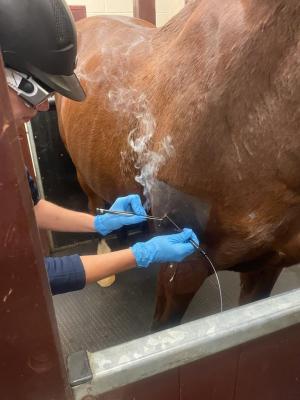Exploring the Benefits of Laser Treatment in Horse Treatment for Improved Healing
The development of laser therapy in equine therapy provides an appealing avenue for enhancing healing and general well-being. Especially reliable for soft tissue injuries, laser treatment likewise plays a significant role in managing persistent pain and improving blood circulation. Its ability to enhance collagen production even more contributes to cells honesty.
How Laser Treatment Functions
Laser therapy, an advanced modality in equine therapy, runs by releasing specific wavelengths of light to pass through tissues and promote cellular processes. This sophisticated modern technology uses the power of photons to connect with chromophores within the cells, causing photochemical reactions that enhance mobile metabolic process. The primary system includes the absorption of light by mitochondrial chromophores, resulting in increased manufacturing of adenosine triphosphate (ATP), the cell's energy money.
The elevation in ATP degrees speeds up numerous biological procedures, including boosted protein synthesis and cell proliferation. Additionally, laser treatment regulates inflammatory feedbacks by minimizing pro-inflammatory cytokines and enhancing anti-inflammatory cytokines. This double action aids in reducing pain and advertising cells repair work.

Benefits for Soft Cells Injuries
When resolving soft cells injuries in horses, laser treatment supplies a wide range of benefits that considerably enhance healing results. Soft cells injuries, including ligaments, ligaments, and muscles, prevail in equine professional athletes and typically require considerable recovery durations. Laser treatment, or photobiomodulation, advertises cellular regrowth and enhances cells repair work by stimulating mitochondrial task, therefore increasing the all-natural recovery procedure.
Among the key advantages of laser treatment is its capacity to decrease swelling. By targeting the afflicted location with particular wavelengths, laser treatment alleviates the inflammatory feedback, reducing swelling and connected discomfort. This anti-inflammatory effect is essential in managing the first phases of injury, where extreme swelling can impede recovery.

In addition, laser therapy promotes the production of collagen, a crucial protein for keeping the honesty and flexibility of soft tissues. Raised collagen synthesis increases the repair service of broken frameworks, reducing the risk of reinjury. As a result, laser therapy provides a non-invasive, drug-free option for speeding up the rehab of soft tissue injuries in equines.
Handling Chronic Pain
In the world of equine health care, taking care of persistent discomfort offers a substantial challenge, often needing diverse strategies for efficient treatment. Persistent pain in steeds can originate from a selection of sources, consisting of arthritis, laminitis, and various other degenerative conditions. Traditional management methods, such as anti-inflammatory drugs and physical treatment, have their merits but can be limited blog here by adverse effects and inconsistent efficacy.
Laser treatment has actually emerged as an appealing adjunctive treatment for managing chronic discomfort in equines. This non-invasive technique utilizes particular wavelengths of light to penetrate cells, promoting cellular fixing and minimizing inflammation. By improving microcirculation and stimulating the launch of endorphins, laser therapy can give considerable pain relief without the unfavorable effects frequently connected with drugs.
The capability to target specific pain websites precisely makes laser treatment see here now a flexible tool in the thorough pain monitoring toolbox. As research study proceeds to evolve, the integration of laser therapy in equine persistent discomfort monitoring holds substantial potential for enhancing the quality of life for affected steeds.
Enhancing Recovery Times
Structure on the appealing outcomes observed hurting administration, laser treatment likewise shows substantial potential in enhancing healing times for equine individuals. This method functions by speeding up cellular regeneration and enhancing blood circulation, which are vital variables in the recovery process. The application of laser treatment promotes the production of adenosine triphosphate (ATP), consequently raising the power offered for cellular repair service and decreasing swelling.
Clinical researches have actually shown that horses treated with laser treatment show quicker recovery from musculoskeletal injuries, surgeries, and soft tissue damages. The reduction in swelling and discomfort not only aids in faster cells repair service yet also allows for earlier and more reliable rehab exercises. This is especially beneficial for performance horses, where lessening downtime is important for keeping competitive routines.
In addition, laser therapy can be precisely targeted to particular injury websites, making sure that the healing impacts are local and potent. This precision lowers the likelihood of negative effects and promotes more regular recovery outcomes. As a result, equine veterinarians are increasingly integrating laser therapy right into their therapy methods, identifying its efficiency in speeding up recovery times and boosting the overall healing procedure for equine clients.
Improving Total Well-being
As laser therapy remains to acquire traction in equine medication, visit their website its benefits expand beyond just injury healing, dramatically adding to the total wellness of steeds (Equine Therapy). This therapeutic method has actually demonstrated efficiency in minimizing chronic pain, lowering inflammation, and advertising cellular regeneration. Such end results are not just crucial for recuperation yet likewise improve the lifestyle for equine patients, guaranteeing they remain energetic and web content
Among the crucial aspects in which laser treatment aids in boosting total well-being is via its analgesic effects. Discomfort monitoring is important for steeds, particularly those associated with affordable sporting activities or strenuous activities. By minimizing pain, laser treatment enables these animals to execute ideally and minimizes the risk of offsetting injuries.

Conclusion
In recap, laser therapy offers a substantial advancement in equine treatment by promoting mobile regeneration, lowering inflammation, and accelerating healing procedures. This non-invasive method alleviates pain, improves blood flow, and advertises reliable nutrient distribution to damaged tissues. Additionally, the therapy's capacity to boost collagen manufacturing makes certain the upkeep of cells stability. Laser therapy emerges as an important tool for maximizing rehab and boosting the overall well-being of horses.